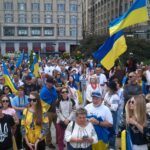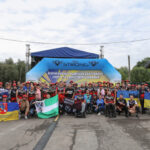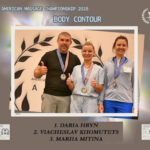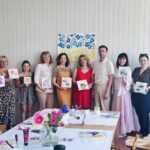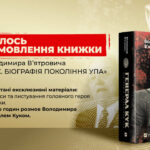A new photo exhibition of wartime life in Ukraine shows the work of Howard G. Buffett.
Making its U.S. debut in Chicago on Wednesday, July 2nd, the exhibit by the American philanthropist, businessman, farmer, former politician and photographer is on display at the Ukrainian National Museum through September 7th.
By Olga Ruda,
Editor of the Ukrainian People Magazine
Meant to shed light on the war and death affecting Ukrainians as a result of the three-year Russia-Ukraine War, Buffett’s gallery “Courage of a Nation” debuted in the U.S. on Wednesday, July 2nd. He started documenting the war after Russia sent troops to invade Ukraine in February 2022.
Buffett, the eldest son of billionaire investor Warren Buffett, first visited Ukraine in 1991. Since then, he’s been to the country more than 20 times. He’s also provided aid to war-torn communities across Ukraine through his philanthropic organization, The Howard G. Buffett Foundation, which focuses on improving global food security and supporting vulnerable and marginalized people living through conflict.
Buffett has worked with world-renowned photographer, two-time Pulitzer Prize winner and National Geographic explorer Muhammed Muheisen to put together the gallery, which includes two models built and designed by artist Thomas Doyle.
One miniature depicts Saint Michael’s Square in Kyiv, the capital of Ukraine. The other one is of an apartment building in the town of Borodyanka. They were both created using Buffett’s photography as a reference.
Also in attendance at the gallery’s opening were Ald. Gilbert Villegas (36th), whose ward includes the Ukrainian National Museum. Aistė Jakštienė, from the Consulate General of Lithuania in Chicago, and Serhiy Koledov, from the Consulate General of Ukraine in Chicago.
On behalf of the magazine Ukrainian People, I asked Mr. Buffett to tell the Ukrainian community of Chicago about his charitable activities, the war in Ukraine, and Ukrainians.
- Buffett, allow me to sincerely thank you for your impressive photographs that we were able to see at the photo exhibition at the Ukrainian National Museum. Each photo is unique in its own way and makes one reflect on the suffering of people during the war. After viewing them, any conscious person would likely ask themselves: What can I do for Ukraine? How can I help? A few years ago in Canada, a bus tour was organized to raise awareness about the Holodomor of 1932–33 in Ukraine. A large tour bus was converted into a mobile cinema, traveling through Canadian provinces and educating students, educators, lawmakers, and officials about how an entire nation was targeted for extermination by hunger. Do you see the possibility of doing something similar with your exhibition in the United States? Are there any plans to tour the states with it?
- Thank you – I’ve always viewed my photography has a tool for sharing the circumstances of the places where our Foundation operates. Words are usually insufficient to explain extraordinary circumstances like the war in Ukraine. We always hope that seeing what’s happening will also inspire action to help address those circumstances. We actually opened a version of this exhibit in Ukraine last month using three converted rail cars to create a mobile “Art Train” that is currently traveling throughout the country. We hope to find a way to do something similar in Europe where we have a partner who can implement the project. It’s all about finding the right partners since we can only provide the funding; we don’t have staff who implement projects. Unfortunately, we don’t have the same kind of partnerships in the U.S. to do a mobile exhibit here but we are grateful to the Ukrainian National Museum for hosting this exhibition. We also have an online book titled “Courage of a Nation” displaying photos from the first three years of the full-scale conflict that is available on our foundation website.
- What can we do to ensure that as many senators and congressmen as possible see your powerful images of the war in Ukraine?
- Our focus on public education is broadly defined. As a private foundation, we cannot engage in political advocacy of any kind. Of course, we hope a broad cross-section of the public has the opportunity to see these and other images so they can better understand the crimes against humanity committed by Russia, the theft of children by Russia, the torture of civilians and the incredible toll that these violations of law and humanity are having on the Ukrainian people. That education can hopefully better inform people so that they can express their opinions as well as mobilize humanitarian support.
- We used to constantly look for information about your famous father and his successful projects, but today it seems the world knows more about you and the work of the Howard G. Buffett Foundation (a school janitor once told me that today you are her hero). You have been to Ukraine 20 times during the war. Your foundation has already donated an incredible $800 million to Ukraine and its people —funding landmine clearance, supporting Ukrainian farmers, restoring local infrastructure, establishing a prosthetics center, and much more. You have done more for Ukraine than some European governments. I am curious: What motivates you to donate such enormous sums to a foreign country and its people suffering from war?
- We have surpassed $1 billion in support this year but we started out with a modest budget in 2022 for several reasons, including ensuring we didn’t abandon our other priorities, and I’m proud to say we haven’t. When Russia launched its full-scale invasion in 2022, I immediately understood the implications for global food security. But I had no idea the level of criminal activity and the violations of international law that Putin would carry out against civilians. He is also violating international laws governing how war is prosecuted.
When I made my first visit after the full-scale invasion in April of 2022, I was focused mostly on food security, both in Ukraine and globally. However, this changed quickly as I realized that Putin and the Russian military’s end goal was genocide against Ukraine and its people. It became clear that Putin wants not just to take away Ukraine’s freedom and sovereignty but to destroy its language, culture, history and heritage. Putin wants to eliminate everything that represents Ukraine. This changed my outlook and our foundation’s level of engagement.
Years ago I met the American General Stanley McChrystal in Afghanistan and he said something that has always resonated with me: “Every once in a while, in our personal lives we get a test on whether we are going to do the right thing or not. Whether we are going to show strength. Whether we are going to show compassion. Whether we are going to do what we have to do.” I believe Ukraine was a test for me and for our foundation to recognize that the war in Ukraine was the biggest intersection of our two mission areas – global food security and conflict mitigation – that we might see in my lifetime. I do not believe everyone will have a test put in front of them during their lifetime. The big question is if you recognize it when it comes and, just as important, will you act on it. We are acting on it, but I do not feel we could have done anything differently.
– According to various estimates, about 20,000 people in Ukraine require prosthetics due to the war. This number may be even higher, as the war continues and the number of wounded grows. In particular, many service members need prosthetic care. How did the idea to open a prosthetics center in Lviv come about? What are the criteria for selecting candidates for prosthetics?
– Superhumans is a perfect example of what we try to do with our funding. When we learned about Superhumans, it was a great idea that had a lot of broad-based and high-profile support, but it didn’t have the money to get it built or to start operating. I consider our philanthropic dollars as risk-tolerant investment capital. We like to invest in great ideas– and great people like Olga Rudnieva — to implement great ideas like Superhumans. Some work, some fail. Superhumans has not only worked, it has exceeded all expectations. And it is, unfortunately, going to be one of the most needed investments in Ukraine. When you walk into Superhumans you meet heroes. You are inspired and you realize that people who might otherwise feel as if they are victims really become super humans because of the medical care and support they get from Superhumans.
We plan to continue working with Superhumans to build a national job training and reintegration facility. Ukraine will need to harness the capacities of everyone in the country to rebuild after the war. Doing that will require unique investments in the individuals who sacrificed for their country and still have incredible talent and skills. When you walk out of Superhumans, you understand why Ukrainians will never stop defending their country.
- Do you plan to continue supporting Ukraine, and can you share in which areas?
- We plan to continue to support Ukraine primarily in food security, humanitarian demining, agriculture, documentation of war crimes, prosthetics and support for emergency responders. We do not think of our work in Ukraine as charity, we think of it as an investment in supporting the future of a democratic and independent Ukraine.
- We know you have been close to the front line, including in Sumy and other frontline towns and villages. Your photos tell the story of what you have seen there. You have met with ordinary people, farmers, volunteers, soldiers, and children. How would you describe Ukrainians? What impressed you the most during these interactions? You distributed food on a large scale — what did you feel in those moments?
- I travel to the front line so that I can understand the war and its implications for our humanitarian work. You cannot understand the war from a hotel room in Kyiv. You must see the damage; you must hear the stories firsthand and you must experience the sadness and anger of the people living through this day after day. It helps me understand what we can do and what the greatest needs are at that time. As a foundation we cannot support the military, but we can support a broad range of civilian needs driven by Russia’s attacks. So, we can help with meals, prosthetics, medical needs, warming centers, infrastructure and many different targeted ways that Putin’s army is trying to push civilians to give up. Ukrainians are brave, resilient, determined, and innovative. Putin has seriously underestimated the people he is fighting, just as so many experts predicted Ukraine’s quick defeat right after the full-scale invasion. I have traveled to over 150 countries, I have seen many resilient people surviving through challenging circumstances but never an entire nation like what I’ve found in Ukraine. I would also describe some Ukrainians as my best friends. I have witnessed a spirit in Ukraine that I have never seen or felt before. Despite the unending, unjustified, and ruthless attacks by an enemy coming to destroy the country and families and businesses, Ukrainians have stood their ground.
When Russia began its full-scale invasion, they clearly had three main objectives common to war: surprise, confusion and fear. All have failed. Fear is Putin’s last remaining target. From what I have witnessed, he will fail to defeat the Ukrainian people. When I am at our food distributions, I often feel anger. We should not be there because we should not be needed. I see people who have been independent all their lives and they are now humbled because of a tyrant. In some villages I see the sad irony of farmers who have helped feed Europe and the Middle East, who have supported humanitarian food distributions to some of the poorest parts of the world, and now they are forced to accept food boxes. It seems very wrong to me to witness this happening.
- Ukrainian farmers — a topic close to you as a farmer yourself who understands all the pitfalls of this field. What challenges have you observed among Ukrainian farmers? Can they be resolved during wartime conditions? What are the differences between farming in the U.S. and in Ukraine?
- Farmers have been especially hard hit. It’s everything from landmines that prevent them from entering their fields to the Russian military targeting wheat fields with drones designed to set fire to the crops. I’ve read that 160,000 pieces of farm equipment have been destroyed and there has been $100 billion of damage to the agricultural sector. Farmers still owe money for loans on much of the destroyed equipment. Farmers are also contending with fields littered with military fortifications, sometimes requiring security teams to travel with them to their fields. They are prevented from accessing fields located in restricted military zones and have to navigate destroyed grain elevators, transportation interruptions and challenges with exports. All have had a negative impact on crop prices. Farmers have experienced reduced productivity due to disruptions in the supply chains for fertilizer and seeds and challenges with labor persist due to conscription and voluntary support for the military. It’s worth mentioning that nearly 25% of Ukraine’s farmland is currently under Russian occupation and being used to fund this war on Ukraine. Honestly, I do not know how farmers continue, especially in the Eastern areas. We support programs for demining agricultural land and programs to help farmers borrow equipment or replace destroyed equipment, as well as access inputs so they can start to rebuild. But it is not enough. Our support is replacing a small fraction of what farmers have lost, and we are only able to support the smaller farmers who are most in need. Despite the ongoing fighting, some of these issues can be resolved, but the question is what resources are needed. They are enormous and truthfully the government must put most of its resources towards winning the war. There are a lot of similarities between Ukrainian farmers and American farmers and Ukrainian farmland and American farmland so seeing all this destruction and the unique challenges farmers in Ukraine must face because of the war feels both unimaginable and very relatable.
- What is your favorite Ukrainian dish?
- I’m not a very adventurous eater. Chicken Kyiv!
- At times it seems that the war in Ukraine is slowly disappearing from American news. People are getting tired of hearing about it — so are some senators and congressmen. What can we do to keep them informed about the war in Ukraine? To ensure that the war doesn’t disappear from the front pages of newspapers or get pushed to the back?
- Every war of this scale has gone on for a long time, so it will come and go from the headlines. That is normal. My biggest concern is the Russian propaganda that is being fed to audiences in the United States and Europe. That is very difficult to counter and it can be very effective. I’m most surprised that Europe is not doing more, and doing it faster. Europe has the most to lose. I wish Western democracies would remember the lessons history has taught us through two world wars. It is the main reason I take photographs. A picture is still worth 1,000 words. It is the way I can communicate what I see and what Ukraine is enduring.
- You are a person who firmly stands on the side of good and has already done many good deeds for the world. A saint, as my grandmother would say (if she were alive). You could be living comfortably in your home, working or relaxing. Yet you choose to take risks and travel to the world’s hot spots — most recently, war-torn Ukraine. I’m trying to understand: What drives you to do this?
- I have never used the word evil, but the war in Ukraine changed that. Putin’s war is the clearest manifestation of evil I have seen in my lifetime. There is a famous quote, “The only thing necessary for the triumph of evil is that good men do nothing”. And of course, women! I cannot say what truly motivates me, but I am driven to do what I can to help people. My mother taught me to help others and my father encouraged it. I am a product of this environment. I also believe that whatever you have, you can lose. I do not care who you are or how much you have, anything can happen. So, when I see what is happening in Ukraine in a certain way I internalize it, and I realize this could be happening to me. I do not think a moral person could stand by and do nothing.
- Have you ever been scared and thought of not returning? After all, you are putting yourself in serious danger.
- I can remember being scared one time, and it was in Kharkiv. That is actually saying a lot because I have been in a helicopter in Congo that was hit by a PKM round, detained in several countries for photographing and had an AK47 put into my chest on four different occasions in different African countries. I have also sat in an underground bunker with my friends from the Achilles Regiment while Russian shelling was dropping dirt on top of us like a hail storm. But the time I was scared was lying in bed one early morning when missiles were hitting the city of Kharkiv. I felt a knot in my stomach. I told myself there was nothing I could do and about then another missile hit, and it shook the room. For about 30 seconds I was scared, then I worked on going back to sleep. There is a reason I am telling you this story, not just to answer your question. Every citizen in Ukraine has experienced this anxiety and fear. Many of them were lying in bed like I was. The toll this takes day in and day out cannot be understood or appreciated unless it is experienced. I got to go home a few days later. Ukrainians feel these feelings every day and every night. This is nonstop terror executed by a person who is using it as a strategy of war. I really do not know how to adequately express it. No, I have never thought about not returning to Ukraine. I will return as long as my friends are fighting and as long as I am welcome and feel like our foundation can help.
- What gives you grounds for optimism and belief in Ukraine’s victory? What gives you confidence that the world will contain the threat of a third world war?
- My wife says I am the most optimistic pessimist that she knows. So, I am not always optimistic. However, this war is so important, and I believe it can become World War Three, that I have to believe right prevails over wrong. It is my belief there are enough good individuals who understand what is at stake and what history tells us can happen to prevent Ukraine from failing.
- What influence did your parents and environment have on shaping you as a successful businessman and, more importantly, as a philanthropist and daring photographer who travels the world, often to its most dangerous corners? Would you like your son to continue your work?
- My parents encouraged me to do what I love. And I have been fortunate to find and do several things I love. I find the challenges of business intriguing. Philanthropy gives me a way to help many people who were not provided the same opportunities I received. And I love farming – it is where I find my peace. And photography is a way to document the injustices I see in the world. I do not think about where I go as dangerous, just as necessary to tell the story. Journalists do it all the time. The biggest difference is that I combine it with my philanthropy, and it has provided more opportunities to help in places I would never have known about.
- Does your wife support you in your charitable work? In your business decisions?
- My wife has been my biggest supporter. She has helped me through my political career and my business career. She has been the most unwavering and steadfast part of my life.
- What would you like to say to the Ukrainian diaspora, most of whom are also trying to help their relatives, friends, or acquaintances in Ukraine who are in need?
- My answer right now is to do anything you can do to support Ukrainians still living in Ukraine, no matter how large or how small. Write letters to soldiers on the front line, even if you don’t know them. Donate money to buy a single prosthetic for someone. Send vegetable seeds to a village. Collect donations of any kind to support children in Ukraine. Collect medical supplies to send over. Support comes in many ways. It is sometimes the spirit behind that support that is the most important. Ukraine must stay together; it cannot afford to become divided. Division is in part the way that Russia wants to defeat Ukraine. Ukrainians must stay unified for Ukraine to continue to survive. Long-term, I would urge especially young Ukrainians to think about how you can return to your country and rebuild it. There will be so many opportunities and based on what I’ve seen Ukrainians accomplish during the war, I can only imagine what is possible when they finally achieve peace.
Slava Ukraini!

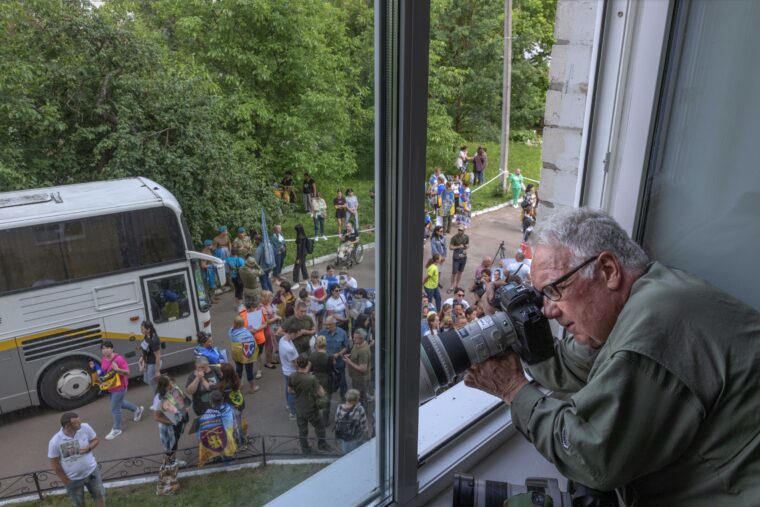







Howard G. Buffett’s ‘Courage of a Nation’ Photo Exhibition
When: Through Sept. 7
Where: Ukrainian National Museum, 2249 W. Superior St.
Tickets: $10 general admission
Info: ukrainiannationalmuseum.org

